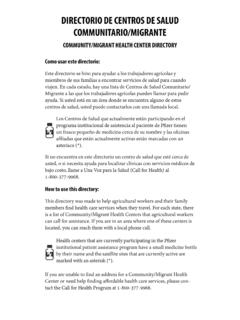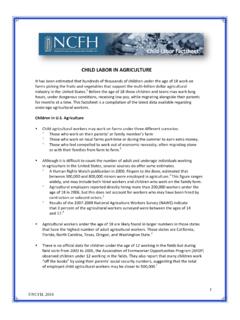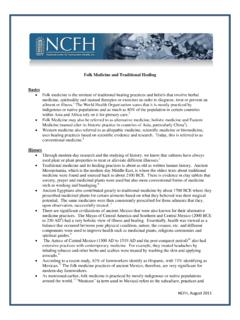Transcription of AGRICULTURAL WORKER OCCUPATIONAL HEALTH & SAFETY
1 NCFH, November 2017 1 AGRICULTURAL WORKER OCCUPATIONAL HEALTH & SAFETY According to a 2015 report of the Bureau of Labor Statistics of the Department of Labor, agriculture remains one of the most dangerous industries in the United States with the highest incidence of fatal workplace Farmworkers face workplace hazards similar to those found in other industrial settings, such as working with heavy machinery and hard physical labor. They also face unique OCCUPATIONAL hazards specific to farm work, including pesticide exposure, skin disorders, infectious diseases, respiratory problems, hearing and vision disorders, and musculoskeletal injures.
2 The following is a compilation of recent facts and figures pertaining to the OCCUPATIONAL HEALTH and SAFETY of farmworkers. General Information In 2015, there were 570 fatal OCCUPATIONAL injuries within the AGRICULTURAL industry, and, agriculture had the highest rate of fatal OCCUPATIONAL injuries: fatal injuries for every 100,000 full-time The AGRICULTURAL industry also has a high number of cases involving nonfatal OCCUPATIONAL injury and illness that required either time off from work or job transfer and restriction. Over 18,000 injuries and illnesses resulting in time away from work occurred in 2015 in the agriculture, forestry, and fishing industry, resulting in an incidence rate of 189 injuries and illnesses per 10,000 full-time workers compared to 104 per 10,000 in all Children in agriculture are also at great risk: the Department of Agriculture released a report in 2009 that recorded 15,876 injuries to youths under 20 years of age who lived, worked or visited a The following data for 2009 was also noted.
3 O Fifty-eight percent of youth injuries were incurred by males o Youth ages 10 to 15 incurred the highest number of injuries at 6,912 o Youths under age 10 incurred 4,111injuries o Youths ages 16 to 19 incurred 4,148 injuries5 Every day, about 100 AGRICULTURAL workers suffer lost-work-time injuries, and an estimated half of injuries among crop production workers are classified as strains or According to the National AGRICULTURAL Workers Survey 2013-2014, 4% of AGRICULTURAL WORKER respondents reported experiencing a workplace injury in the past 12 months, and 17% reported experiencing musculoskeletal pain or ,5 OCCUPATIONAL HEALTH & SAFETY Factsheet NCFH, November 2017 2 Pesticide Exposure Today, AGRICULTURAL workers are exposed to non-persistent pesticides which are metabolized by the body within days.
4 They may enter the body through ingestion and inhalation, but they are primarily absorbed through the During their daily work, AGRICULTURAL workers are often exposed to pesticides, which include substances that prevent, destroy or repel pests. The term pesticide also encompasses herbicides, fungicides, and various other substances used to control pests. Some pesticides can cause harm to human ,8 AGRICULTURAL workers frequently encounter pesticides through direct contact with the chemicals, contact with pesticide residue on treated crops or equipment, and drift of pesticides into untreated Several studies also prove that entire families are at risk to pesticide exposure because of drift from nearby areas, not providing enough hand-washing or bathroom facilities, and bringing home work clothes that have been ,6.
5 10 The Pesticide SAFETY Education Program of Cornell University states that mild symptoms of poisoning include headache, fatigue, dizziness, nervousness, perspiration, loss of appetite, thirst, eye irritation and irritation of the nose and throat. Severe poisoning symptoms include fever, intense thirst, vomiting, muscle twitches, convulsions, inability to breathe and Exposure to large doses of a pesticide can lead to severe effects such as loss of consciousness, coma and even Lifetime exposure to pesticides is significantly greater for Latino immigrant AGRICULTURAL workers as compared to other Latino immigrant AGRICULTURAL workers.
6 Higher education levels and possessing an H-2A visa were associated with lower lifetime exposure levels to Pesticide SAFETY regulations that exist include: o the WORKER Protection Standard, which states that field workers must be trained on pesticide use, and o the Occupation SAFETY and HEALTH Act, which requires employers with 11 or more employees to provide drinking, toilet and washing facilities for AGRICULTURAL workers while they work in the A study conducted in eastern North Carolina surveyed 300 AGRICULTURAL workers regarding pesticide SAFETY and training.
7 They reported the following: o had water available for hand-washing, but only were provided soap, o were told when it was safe to enter fields after applying, o 51% were told when pesticides were applied, o reported being provided pesticide SAFETY instruction by a supervisor, o 28% percent worked in areas adjacent to fields where pesticides were being applied, o were asked to enter fields before it was safe to do so, o 16% worked in fields while pesticides were being applied, and o were provided with pesticide SAFETY Another pesticide danger for AGRICULTURAL workers is the limited information they are provided about the pesticides they are being exposed to.
8 They may not be told what types of pesticides are being used at any given time, they may have little control over exposure, NCFH, November 2017 3 and they often live in grower-provided housing and do not know the severity of exposure in these One other challenge is that growers rarely speak the same languages as workers. Growers often do not recognize or understand how linguistic, cultural and power differences create barriers for farmworker pesticide Heat and Sun Exposure AGRICULTURAL workers are at increased risk for heat-related illnesses due to the nature of farm work.
9 They work outdoors in direct sunlight, humidity levels are often higher in the fields, they generate large amounts of body heat, and they often use heavy work clothing and Heat stress occurs when the body temperature increases, and the body fails to regulate its temperature. This condition can lead to dehydration, electrolyte imbalance, neurological impairment, multi-organ failure, and A study published in 2008 found that from 1992-2006, 423 workers in agriculture and non- AGRICULTURAL industries died from heat exposure.
10 Results indicated that 68 (16%)of those fatalities were crop workers employed in the crop production or support activities for crop production In a study conducted with 300 AGRICULTURAL workers in North Carolina, 94 percent of respondents reported that they work in extreme heat, and 40 percent reported having had symptoms of heat Research conducted in Georgia with more than 400 AGRICULTURAL workers found that over a third of workers reported experiencing three or more symptoms of a heat-related illness in the past week, and that 34% did not have access to regular rest breaks during the work day, and 27% did not have access to Workplace heat stress can be exacerbated by the poor housing conditions of many AGRICULTURAL workers.





